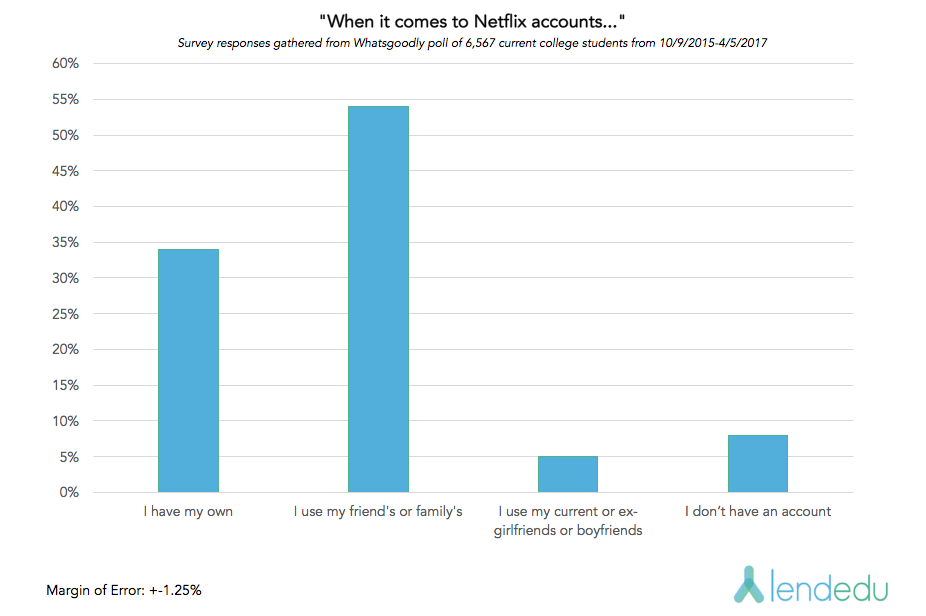Starting as a DVD sales and rental company in 1997 and then introducing their streaming media platform in 2007, Netflix has enjoyed a methodical rise to dominance in the entertainment industry.
According to new data licensed by LendEDU, Netflix continues to be the clear leader in online streaming, but is hurting in one key performance metric.
Netflix’s tremendous success is no secret to anyone. What was once a service that could deliver rented DVDs through the mail has grown far beyond that. Netflix’s website features an impressive collection of blockbuster movies and hit shows that are available to viewers on demand.
In 2011, the company began producing original content known as “Netflix Originals,” and smash hits like House of Cards, Orange is the New Black, Stranger Things, and Narcos were created.
The success of Netflix Originals have begun to rival and even surpass many cable television shows and now seriously threaten the viewership monopoly cable companies have held since the inception of television.
If carving into cable television’s market was not impressive enough, Netflix is now going after a bigger fish: Hollywood. The online streaming company has already produced critically acclaimed movies such as Beasts of No Nation. In recent news, Netflix beat out Hollywood studios and purchased the rights to Brad Pitt’s upcoming film War Machine for a reported $30 million.
The success of Netflix is plainly visible, and it appears likely that their success will only grow in the coming years as the world continues to lose patience with commercials and once-a-week shows. The publicly traded company currently trades at $143.48, and their total assets are valued at $13.6 billion. Netflix also boasts 93 million users worldwide.
In order to become a Netflix user, a consumer must pay a subscription fee of $7.99 per month that grants them unlimited streaming access. The subscription fee is one of the primary ways Netflix generates revenue. It is also a key metric for investors looking to evaluate Netflix’s performance and value.
LendEDU has uncovered new data that validates a long time suspicion: Netflix and it’s investors are being cheated out of revenue by multiple people sharing one subscription.
Millennials are Cheating the Netflix System
In new data licensed by LendEDU, it was found that a majority of millennials are using the accounts of family and friends to watch Netflix.
6,567 millennials were asked to complete the following phrase: “When it comes to Netflix accounts?”

54 percent of respondents said they use a friend’s or family member’s account. Additionally, 5 percent said they used their current or ex-girlfriend’s or boyfriend’s account. Meanwhile, only 34 percent said they have their own account, and 8 percent did not have a Netflix account.
In total, 59 percent of millennials are using someone else’s account to access Netflix’s “subscription-only” content. That is a significant contingent of people, and in turn, a significant amount of revenue not being generated.
With some quick math, we can estimate how much money Netflix is losing just from the respondents of this poll. 59 percent of 6,567 poll participants equates to 3,875 people. Assuming all of these people paid the $7.99 per month subscription instead of mooching off someone’s account, then Netflix is losing out on $371,535 of possible revenue.
Now, that dollar amount seems like pocket change for a huge company like Netflix, but what if you assume these poll numbers apply to all millennials? According to the latest numbers from the U.S. Census Bureau, there are 83.1 million millennials in the United States; they are the largest living generation in the world. Suddenly, Netflix is dealing with some serious losses because millennials are playing without paying.
Factoring out the 8 percent of millennials that do not have a Netflix account, we are left with 76,452,000 millennials that use Netflix. This number may seem unrealistic given that Netflix only has 93 million users worldwide, but it is important to remember that number only represents paying subscribers, not overall Netflix viewers. 59 percent of that number would mean 45,106,680 millennials are using Netflix without their own subscription.
With the assumption that those 45,106,680 millennials would pay for a $7.99 per month subscription, it can be liberally estimated that Netflix and it’s investors are losing more than $4 billion from millennials cheating the system.
Netflix the Clear Leader in Online Streaming
Despite Netflix losing out on some serious cash due to millennials using other people’s subscriptions, things are not all bad for the online streaming giant.
6,660 millennials were polled on the following question: “If you could only have one, which one would you take?”
A whopping 84 percent of respondents answered “Netflix,” compared to 12 percent that said “HBO GO” and 4 percent that said “Hulu.”
Netflix is the online streaming platform of choice for millennials, and it is not even close. This should be welcomed news for Netflix and investors alike. As millennials have grown to be the largest living generation in the world, Netflix can rest easy knowing they have a stranglehold on this demographic.
Now, if they could only get those subscription thieves under control.
Methodology
The data LendEDU gathered for this report was licensed from polling company Whatsgoodly. For the first question, 6,567 current college students were asked to complete the following phase truthfully: “When it comes to Netflix accounts…” This poll was conducted from October 9th, 2015 to April 5th, 2017. For the second question, 6,660 current college students were asked to answer the following question truthfully: “If you could only have one, which one would you take?” This poll was conducted from November 11th, 2015 to April 5th, 2017. We estimate that our sample is representative of the population of college students within a margin of error of +-1.25% and +1.26% respectively.
See more of LendEDU’s Research
